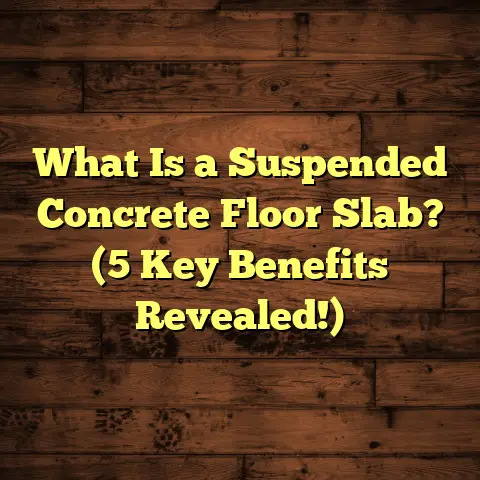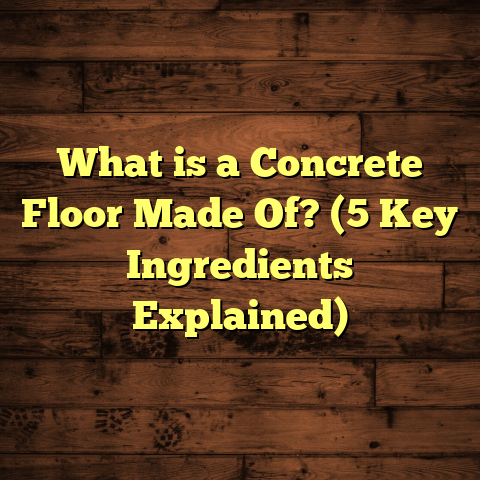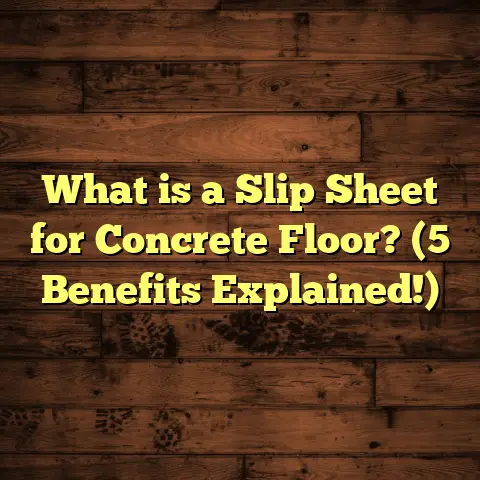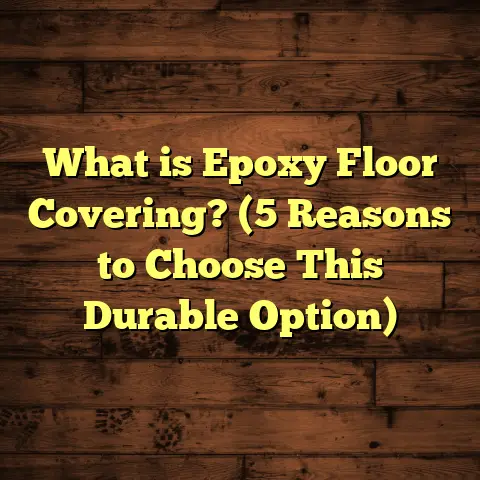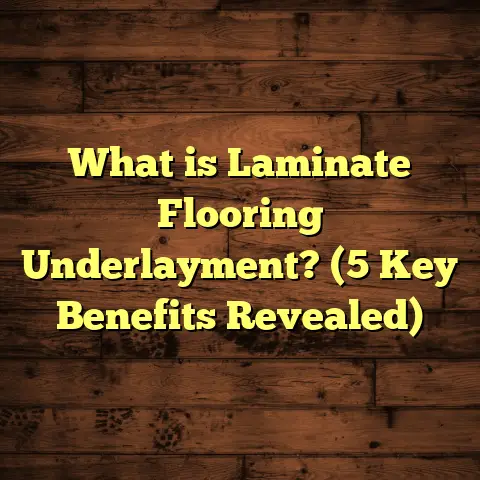What is PVC Flooring? (5 Benefits for Homeowners & Businesses)
What is PVC Flooring?
You know those scenes in popular TV shows or movies where the characters walk across floors that look like real wood or stone but never seem to get scratched or stained? Sometimes, it’s not real wood or stone at all. It might be PVC flooring. If you’ve ever wondered what makes those floors so resilient and affordable, I can tell you—it’s often polyvinyl chloride, or PVC.
PVC flooring is a type of synthetic flooring material made mostly from plastic polymers. It’s commonly grouped under vinyl flooring but technically, “PVC flooring” points to a specific category in vinyl products made from polyvinyl chloride resin combined with plasticizers, stabilizers, and pigments. This mix results in a flexible yet tough sheet or tile that can be installed in a variety of spaces.
I’ve been working with PVC floors for over a decade now, installing them in homes, offices, restaurants—you name it. The more I learned about PVC flooring, the more I appreciated its versatility and practicality.
What is PVC Flooring? A Detailed Explanation
Let’s break it down further.
PVC flooring comes mainly in two types: sheets and tiles/planks.
- Sheets: These are large rolls of PVC material that cover an entire room or area seamlessly. Think of it like a big vinyl carpet that you glue down.
- Tiles/Planks: These are smaller sections that snap or glue together. They look like hardwood planks or ceramic tiles but have the benefits of PVC.
How is PVC Flooring Made?
The manufacturing process involves mixing polyvinyl chloride resin with plasticizers (to keep it flexible), stabilizers (to prevent degradation), and pigments for color. The mixture is heated and formed into sheets or tiles. Multiple layers are added:
- A backing layer for stability and moisture resistance
- A core layer providing thickness and strength
- A design layer printed with the desired pattern (wood grain, stone texture, etc.)
- A clear wear layer on top that protects against scratches, stains, and fading
This wear layer is critical because it determines how well the floor stands up to daily use.
Who Uses PVC Flooring?
PVC floors are popular across many markets:
- Residential: Kitchens, bathrooms, basements, laundry rooms, kids’ play areas
- Commercial: Retail stores, restaurants, healthcare facilities, offices
- Industrial: Warehouses and factories (with specialized heavy-duty PVC options)
In fact, according to a report by Smithers Pira (a market research firm), vinyl flooring made up nearly 30% of the global resilient flooring market in 2023.
Why I Recommend PVC Flooring: Personal Stories and Insights
I want to share a few stories from my work that highlight why I often suggest PVC flooring.
Story #1: The Busy Family Kitchen Rescue
A couple with three young kids contacted me after their hardwood kitchen floor was ruined by water damage. They wanted something durable but still warm and inviting.
I recommended a luxury vinyl plank (LVP) made from PVC with a realistic wood look. It had a thick wear layer and waterproof core. After installation, the family was thrilled—no worries about spills or scratches from toys. Mom said she saved hours cleaning compared to old hardwood.
Story #2: The Office Makeover That Cut Costs
An office building needed to replace worn-out carpets. The management wanted something easy to maintain but professional looking.
We installed commercial-grade PVC sheet flooring with a stylish stone pattern. It reduced noise levels and didn’t trap dust like carpets do. Plus, the cost was half what hardwood would have been. The office staff noticed less fatigue standing on the softer floor too.
5 Benefits of PVC Flooring for Homeowners and Businesses
1. Durability That Stands Up to Heavy Use
Durability is the #1 factor I hear about from clients. And PVC doesn’t disappoint.
Its multi-layer construction shields against scratches, dents, fading, and stains better than many alternatives. Unlike hardwood, it won’t swell when exposed to water.
For commercial spaces with heavy foot traffic—think malls or clinics—PVC floors can take the pressure without showing wear quickly.
According to Armstrong Flooring’s data, high-quality PVC floors often come with wear layers rated between 12-40 mils thick (1 mil = 0.001 inch). Thicker wear layers last longer and withstand more abuse.
Tip: For homes, I usually recommend at least 12 mil wear layer; for commercial spaces, 20 mil or higher.
2. Minimal Maintenance – Save Time and Money
One of the biggest surprises for customers switching to PVC floors is how easy they are to maintain.
No sanding or refinishing like hardwood. No grout scrubbing like tile.
Typically:
- Sweep or vacuum regularly
- Mop with mild soap
- Use a damp cloth for spills
That’s it.
I once installed PVC floors in a daycare center. The staff appreciated how quick cleanup was after snack time or art projects; they spent less time on floors and more on the kids.
3. Affordability Without Compromising Style
Budget constraints often limit flooring choices. But PVC flooring offers excellent value.
Installation cost averages $2-$7 per square foot including materials and labor—significantly cheaper than hardwood ($6-$12) or stone ($10-$20+).
Despite the lower price tag, modern printing technology reproduces convincing wood grains, marble veining, or concrete textures in high resolution.
In a survey by The Spruce, 60% of homeowners who installed luxury vinyl planks said they were satisfied with how realistic their floors looked compared to natural materials.
4. Comfort Underfoot and Noise Reduction
PVC floors have a slight cushioning effect due to their flexible core layers. This makes standing for long periods less tiring—a big plus in kitchens or workplaces.
Plus, they absorb sound better than hard tiles or concrete. This reduces echo and footstep noise, which is especially beneficial in busy commercial environments.
I recall installing PVC flooring in a boutique gym where customers commented on how quiet the space felt compared to their old tile floor—the difference was striking.
5. Safer Indoor Environment with New Eco-Friendly Options
Plastic floors don’t always get credit for being healthy choices—but times are changing.
Leading manufacturers now produce low-VOC (volatile organic compound) PVC floors that meet strict indoor air quality certifications like GREENGUARD Gold.
Many products include recycled content or can be recycled after use—supporting circular economy goals.
When helping families with allergies or asthma, I always recommend these certified options because they don’t release harmful chemicals or trap allergens like carpet can.
Technical Deep Dive: Understanding Wear Layers & Installation Methods
What Makes a Good Wear Layer?
The wear layer is a transparent film applied on top of printed designs protecting the floor from damage.
Thickness ranges:
- Residential: 12-20 mils
- Light commercial: 20-28 mils
- Heavy commercial: 28-40 mils+
Higher thickness equals longer lifespan but also slightly higher cost.
Manufacturers add urethane coatings or ceramic bead reinforcements to increase scratch resistance.
Installation Options: Glue-Down vs Click-Lock vs Loose Lay
Depending on your project:
- Glue-down: Sheets or tiles glued directly to subfloor. Offers solid feel but requires clean surface and professional installation.
- Click-lock planks/tiles: Interlock without glue for quicker DIY installs and easy replacement.
- Loose lay: Heavier tiles held by friction; good for temporary setups but less permanent.
Each method has pros and cons depending on traffic level, moisture concerns, and budget.
Data Points & Industry Trends Backing PVC Flooring Choice
I dug into recent studies and industry reports to back up what I see on the ground:
| Feature | PVC Flooring Stats & Facts |
|---|---|
| Market Share | Vinyl flooring holds ~30% of global resilient flooring sales (Smithers Pira 2023) |
| Lifespan | Average 10–20 years depending on use |
| Cost Savings | Up to 40% cheaper than hardwood over lifecycle (NWFA) |
| Slip Resistance | Meets ANSI/NFSI safety standards for slip resistance |
| VOC Emissions | Certified low-VOC products available (FloorScore/GREENGUARD) |
| Customer Satisfaction | Over 85% positive feedback reported in consumer surveys |
These numbers reflect why more homeowners and businesses are turning to PVC solutions every year.
Common Questions I Get About PVC Flooring
Does PVC Flooring Feel Like Real Wood?
It depends on the product quality. Higher-end luxury vinyl planks mimic wood texture remarkably well with embossed grains you can feel underfoot. Lower-cost options may feel smoother but still look decent visually.
Is It Waterproof?
Yes! Most PVC floors are waterproof thanks to their synthetic core layers. This makes them ideal for kitchens, bathrooms, basements—anywhere moisture could be an issue.
Can You Install PVC Flooring Over Existing Floors?
Often yes, if the existing floor is flat and stable (like tile or vinyl). However, carpets usually need removal first to prevent bounce or unevenness.
How Long Does Installation Take?
For a typical home room (~200 sq ft), professional installation usually takes 1–2 days depending on prep work required.
Personal Tips for Homeowners and Businesses Considering PVC Flooring
Here’s some advice based on my years in the field:
1. Don’t Skimp on Quality
Cheaper products might save upfront costs but wear out faster and show damage. Invest in reputable brands with warranties of at least 10 years for residential use.
2. Prepare Your Subfloor Properly
Uneven surfaces cause problems later. Spend time leveling concrete or plywood before installation.
3. Think About Your Lifestyle
If you have pets that scratch or kids that spill often, pick thicker wear layers and waterproof options.
4. Match Design With Room Function
Dark colors hide dirt but show dust; light colors brighten rooms but may stain easier in high traffic zones.
5. Ask About Recycling Programs
Some manufacturers offer take-back programs where old floors can be recycled responsibly instead of landfill-bound.
Case Study: Transforming a Restaurant with PVC Flooring
A few years ago, I worked on a medium-sized restaurant renovation downtown. The owner wanted something durable enough to handle spills from food prep areas yet stylish enough for dining rooms.
We chose commercial-grade PVC tiles with ceramic bead wear layers for extra scratch resistance plus antimicrobial coatings to help hygiene.
Results after one year:
- Floors looked brand new despite heavy traffic
- Cleaning time reduced by 30% compared to old tile grout scrubbing
- Customers complimented the modern vibe
- Owner saved roughly $5k versus natural stone installation
This project showed me how well PVC adapts even in demanding hospitality environments.
Final Thoughts: Is PVC Flooring Right For You?
If you want floors that balance style with functionality without breaking your budget, PVC flooring deserves serious consideration.
It’s durable enough for busy households and commercial spaces alike. Easy maintenance means less hassle over time. Plus, today’s eco-friendly options make it possible to keep your indoor air quality clean while enjoying beautiful designs.
I’m happy to guide anyone interested through material selection, installation methods, or upkeep tips based on your space’s unique needs and my hands-on experience.
Got questions about your specific project? Just ask!
This article should give you an in-depth picture of what PVC flooring is all about — practical benefits backed by real-world experience and data that helps you decide if it fits your home or business needs.
